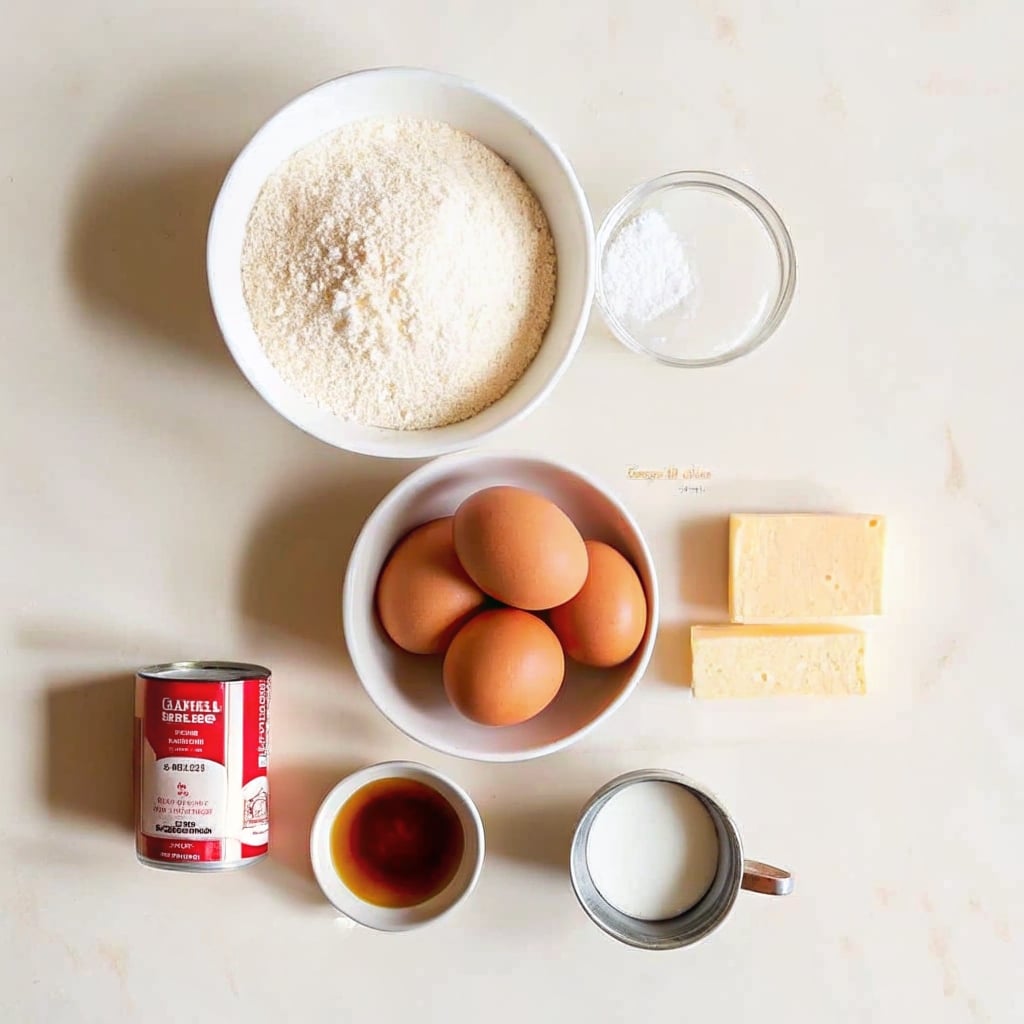Ever wonder why a slice of milk cake with condensed milk feels like a hug? In this article, we’ll explore the nostalgia, texture, and simplicity behind this beloved treat. You’ll discover recipe tips, ingredient swaps, serving ideas, and real-life baking hacks—all structured to help you bake confidently and enjoyably.

Condensed Milk Cake
Ingredients
- 1 cup all-purpose flour
- 1 ¼ teaspoons baking powder if not using self-rising flour
- 4 large eggs, room temperature
- 14 oz sweetened condensed milk
- 4 tablespoons unsalted butter, melted
- 1 teaspoon vanilla extract (optional)
- pinch of salt
Instructions
- Preheat oven to 350°F. Grease and line a 9-inch pan.
- Whisk together flour, baking powder, and salt.
- In another bowl, combine eggs, condensed milk, melted butter, and vanilla.
- Gently fold dry ingredients into wet mixture.
- Pour batter into prepared pan and bake for 45-60 minutes.
- Cool for 10 minutes in pan, then invert onto wire rack to cool completely.
- Dust with powdered sugar and serve.
Notes
Why This Condensed Milk Milk Cake Feels Like Home
When I was growing up, the scent of condensed milk warmed the kitchen long before the cake even emerged from the oven. My grandmother used to sneak spoonfuls right from the can, and that sticky-sweet taste still brings me straight back to her cozy kitchen. That memory inspired today’s recipe—a simple milk cake with condensed milk that feels like a family heirloom in every bite.
Condensed milk isn’t just nostalgia—it transforms a cake’s texture. The sugar and condensed milk naturally thicken, creating a tender, almost custardy crumb and a golden top that hints at toasted caramel . As you bake this milk cake with condensed milk, you’re not chasing complicated techniques—you’re celebrating rich simplicity.
This cake strikes a balance between ease and indulgence, making it accessible for beginners yet satisfying for seasoned bakers. It’s surprising how just a few pantry staples can yield bakery-worthy results.
Mastering the Milk Cake with Condensed Milk
This section dives into what you need and how to execute perfectly—from ingredient essentials to step-by-step baking.
Key ingredients & substitutions
To bake a soft and rich milk cake with condensed milk, you’ll need:
- Sweetened condensed milk (14 oz can): The soul of the cake, its blend of milk solids and sugar brings creamy sweetness and moisture.
- All‑purpose flour (1 cup + extras): Provides structure. Use self‑rising flour or add about 1¼ tsp baking powder per cup if you don’t have it.
- Eggs (typically 4): These bind the batter, add richness, and help it rise.
- Unsalted butter (4 tbsp melted): Adds tenderness and flavor. room‑temperature butter for best texture .
- Baking powder (½ tsp): Ensures a light crumb. Essential if you don’t use self‑rising flour.
- Optional: Vanilla extract, a pinch of salt, or citrus zest boosts depth—but aren’t mandatory.
You can also swap: vegan condensed milk for dairy-free diets, gluten-free flour blends, or brown sugar in place of granulated, depending on what you have.

Step‑by‑step baking method
Follow this clear process for a deliciously tender cake:
- Preheat & prep: Heat oven to 350 °F (175 °C). Grease and line a 9‑inch round or springform pan.
- Mix dry: In a bowl, whisk flour (plus baking powder and salt if needed).
- Combine wet: In another bowl, whisk eggs, melted butter, and condensed milk until smooth. Add vanilla if using.
- Combine batters: Gently fold dry mix into wet ingredients until just combined—overmixing will toughen the crumb.
- Bake: Pour batter into the pan. Bake 45–60 minutes, until a toothpick inserted near center comes out clean (a few moist crumbs are fine).
- Cool: Let cool in pan for 5–10 minutes. Run a knife around the edges, then invert onto a rack to cool completely.
Once cooled, dust with powdered sugar or serve with fresh berries or berry sauce.
Why it works so well
- Condensed milk infuses fat and sugar uniformly, creating moisture and richness without separate sugar.
- Butter and eggs provide structure, flavor, and tenderness. Whisked together properly, they create a cake that’s both light and buttery.
- Minimal ingredients mean minimal fuss, yet this cake delivers bakery-quality results with everyday pantry staples.
Expert Tips & Flavor Variations for Your Milk Cake with Condensed Milk
Let’s elevate your milk cake with condensed milk by diving into expert tips, clever flavor twists, and delicious serving ideas.
Pro tips for perfect texture
- Start with room-temperature eggs and butter—they incorporate more air, yielding a lighter crumb. Cold ingredients can result in dense texture .
- Don’t overmix once you combine wet and dry ingredients. Mix just until no streaks of flour remain—overworking the batter means a tough cake .
- Test doneness by inserting a toothpick into the center around minute 45. It should come out clean or with a few moist crumbs; under-baking gives a soggy middle, and over-baking dries it out .
- Let the cake cool fully before dusting or slicing. This helps it set properly, making it easier to cut clean slices.
Creative add-ins and pairings
- Bright berries or compote: Top the cake with fresh strawberries or a homemade berry sauce for a pop of color and balanced sweetness—similar ideas are detailed in Berry Sauce Recipe.
- Citrus zest twist: Gently fold in lemon or orange zest into batter for a hint of bright, citrusy aroma that cuts through the sweet richness.
- Nutty crunch: Sprinkle chopped almonds or walnuts on top right before baking to add texture and visual appeal.
- Cream topping options: Whip heavy cream with a touch of vanilla and dollop it over each slice, or layer whipped mascarpone between slices for an elegant dessert.
These tweaks transform the cake into a versatile dessert that adapts to seasons and personal taste—without losing that comforting base.
Serving & Storage Made Simple
After baking your perfect milk cake with condensed milk, let’s make sure you serve and store it to maintain its rich, tender texture.
Best ways to present and serve
Presentation adds that final touch of warmth to any dessert. Once fully cooled, lightly dust your milk cake with powdered sugar to highlight its beautiful golden top. For a touch of freshness, top each slice with vibrant berries like raspberries or sliced strawberries. A drizzle of homemade berry compote from Berry Sauce Recipe creates a stunning and flavorful plate.
If you’re hosting, consider pairing slices with a dollop of softly whipped cream or even a swirl of vanilla frosting, inspired by the Vanilla Frosting Guide. These add-ons balance the condensed milk’s sweetness while providing contrasting textures.
This milk cake with condensed milk also shines as part of a brunch spread alongside a fresh fruit platter or a warm cup of coffee. Thanks to its moist crumb, it stands alone beautifully too—perfect for casual gatherings or more festive occasions.
How to store, freeze, and reheat
Proper storage helps preserve your cake’s soft, creamy crumb:
- Refrigeration: Store cooled, unsliced cake wrapped tightly in plastic wrap or in an airtight container. It keeps well in the refrigerator for up to 5 days without drying out.
- Freezing: Wrap individual slices in plastic wrap, followed by aluminum foil or a freezer-safe bag. Freeze for up to 2 months. Thaw overnight in the fridge for best texture.
- Reheating: For a slightly warm slice, microwave for 10–15 seconds or gently warm in a low oven (300°F) for a few minutes.
Following these simple storage methods keeps your milk cake with condensed milk irresistibly tender, even days after baking.
You can find more on the different uses of condensed milk in our Crumb Recipes Facebook Page
FAQ’s
What does condensed milk do to a cake?
Condensed milk adds both moisture and sweetness to the cake. Its high sugar content contributes to the golden crust while creating a soft, custard-like crumb that stays moist longer than traditional recipes.
Can I use condensed milk for baking?
Absolutely. Condensed milk works beautifully in a variety of baked goods like cakes, bars, and even cookies. It not only replaces some of the sugar but also enriches texture and flavor.
Can condensed milk replace eggs in cake?
Condensed milk can partially replace eggs by contributing moisture and binding, but it doesn’t fully replace the structural proteins eggs provide. Most recipes, including this milk cake with condensed milk, still require eggs for proper structure and rise.
Can I use condensed milk instead of sugar in cake?
Yes, condensed milk can substitute for sugar since it’s already sweetened. When using it, reduce or eliminate added sugar in the recipe to avoid overly sweet results.
Conclusion
Baking a milk cake with condensed milk is like revisiting the comforting flavors of home. Its simple ingredient list transforms into a tender, golden cake that works for any occasion—from casual coffee breaks to celebratory brunches. By following these easy tips and variations, you’ll create a moist, flavorful dessert that will quickly become a favorite in your kitchen. So grab a can of condensed milk, preheat that oven, and enjoy the sweet magic of homemade baking.


